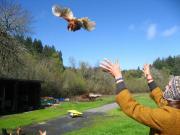project:
Open Source 3D Scanning System
program:
Fablab Location:
Waag Society
3D- Scan Project
We want to create an affordable and precise 3D scanner for the scanning of body parts.These scans will be used to create proper prosthetics, which resemble the real body as much as possible. The project is a collaboration of the Fablab Amsterdam and the HONF society in Yogyakarta. The aim of this project is to be able to create a 50$ prosthetic leg, which suits the requirements of the physically challenged Indonesian people. The minimum cost for a prosthetic leg in Indonesia is currently 250$. This price is mostly fixed on the high material cost and the high costs of the 3D scanner. Therefore it is of most impotents to give the world a low-cost 3D scanner, preferably with open source software.
Research 3D-Scan software
We want to try different sorts of software for the 3D scanners as to see which is most suitable for the job. The most important values we want the 3D scanner to have are:
· Precise scan of the body part to create a perfect match negative for the prosthetic.· Fast scan of the body part, with a minimum of 20 legs every day.· The scanner generates open source output files.· The total costs of the 3D scanner are below 350$.
There are several open source 3D scanner software’s available which might suite our needs. We are going to start testing the following software:
· David-Laserscanner software· Splinescanner software
David-Laserscanner
The David-Laserscanner is an open source 3D scanner with a relative cheap setup. For the scanning process you need a camera, an alignment laser and a reference point within a 90˚ angle. The higher the quality of the camera and the laser the better your result is going to be. We used a Sony 3CCD Handy Cam and a 5V alignment Laser. The reference point setup is distributed by the David-Laserscanner software.
Practical Research David-Laserscanner
The 1st test we run with David software we used the reference points the size of an A4. The camera was positioned in a straight line with the object we want to scan. The laser is manually moved up and down on the left and right sides from the camera. This is to create as much dots so the David software can produce a well reconstruction of the object. We decided to make a couple of scans with the object turning 120˚ every run. We used a cup as the object in the 1st test, here are the results in Rhinoceros:Settings per scanDuration: 15 MinNumber of laser positions: 2 vertical lines (left & right from camera viewpoint) Brightness: Full brightness
The results of our 1st scan had a lot of garbage for such a solid object. This is caused by a number of factors:
· The cup has a reflection layer which offset the laser and reference points.· The laser is not sharp enough.· The scan was taken in the midday; therefore there was a lot of light in the test area which interferes with the laser/object contrast.
The good result of our first test was that the David software generated a lot of dots. This means that under the right circumstances we could create a very detailed scan of a body part.
The next step is to remove the garbage and try to mesh the different angles of our cup into 1 solid object. For this 1st test we decided the scans were not good enough to continue to the meshing part.
The 2nd scan we did was the scan of a hand. We decided that the next object should not reflect in any way. We only took a scan from the front side, just to see whether we were right about the garbage being produced by the reflection of the object. Here is the result in David-Laserscanning and Rhinoceros:
Settings per scanDuration: 15 MinNumber of laser positions: 2 vertical lines (left & right from camera viewpoint) Brightness: Full brightness
